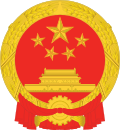| Ambassador of People's Republic of China to the Republic of the Philippines | |
|---|---|
| 中国驻菲律宾大使 | |
 | |
| Appointer | The president pursuant to a National People's Congress Standing Committee decision |
| Inaugural holder | Xiao Te |
| Formation | October 1975 |
| Website | Chinese Embassy, Manila |
The ambassador of China to the Philippines is the official representative of the People's Republic of China to the Philippines.
